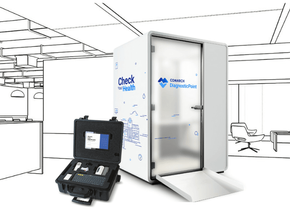Earth observation and imaging in insurance underwriting

The increased frequency and severity of disastrous natural catastrophes is exerting both a human cost and significant amounts of insured losses, presenting an existential threat to insurers. The entire insurance sector relies on strong data from the outset, so volatile and unpredictable risks seriously hamper the industry’s ability to thrive.
Nat cats are a risk both in terms of property insurance – freak weather events like storms, floods and earthquakes often leave millions of dollars’ worth of destruction in their wake – as well as agricultural insurance, wrecking crops and making it harder for growers to earn a living from one season to the next.
One of the most championed risk technologies, which could potentially help insurers mitigate against the mounting threat posed by climate change, is satellite observation and aerial imaging. It’s not a new concept; it is, after all, the same underlying technology that connects our smartphones and powers Google Maps.
But adoption has traditionally been limited among insurers, due to the high cost associated with satellites. But all of that is changing. Reijo Pold, Founder & Chief Strategy Officer at Value.Space, explains: “Historically, satellites have been used selectively across the insurance spectrum due to high costs, with post-catastrophe analyses being the well-known use case to date. Now, we are seeing a surge in claims and losses globally that are primarily driven by changing climate patterns, that is pushing already brittle infrastructure to breaking points.
“This is also starting to inflict damage to properties and cities on a large scale as well. Insurers today want to analyse risk ahead of time to make more accurate decisions and improve their loss ratios. This capability exists today – we have made it cost-effective, and it will be even better in the years ahead, with new satellite capabilities coming online.”
What are the main use-cases for satellite imaging in insurance?
Owing to the nature of aerial imaging and photography, drones and satellites can prove immeasurably powerful for the insurance sector. They are able to take in huge swathes of data – more than any human is able to process – and make sense of it, either for the purpose of loss adjustment or risk assessment.
The insurance verticals most conducive to the use of earth observation, aerial imaging and satellite technology are those where timely, accurate data on geographical and environmental conditions are crucial,” says Mark Costello, Co-Founder & CEO of commercial insurance broker Taveo.
The continuous influx of real-time data from these technologies can lead to more dynamic insurance models; better risk management; and more accurate, faster claims processing across these verticals.
Within each of these insurance lines, there are multiple individual use-cases such as risk assessment, fraud detection and claims handling that can be supported using aerial and satellite technology.
Robert Kozikowski, Co-founder and CPO at Tensorflight, a Polish-American insurtech that uses satellite imagery and AI to provide insights into the physical characteristics and risk profiles of buildings on the ground, elaborates: “With satellite imagery, we can evaluate every global structure, gather building-related information (such as building dimensions, construction type, nearby vegetation, and potential hazards) and detect changes to properties.
“This includes damage analysis following natural disasters, such as hurricanes and within conflict zones, where on-the-ground inspections are impossible and other sources of imaging are unable to provide the level of detail required for the insurance process. We also operate in the agricultural space and use satellite imagery to monitor crop health and forecast potential crop damage.”
The technology is currently used to analyse risk and adjust for loss once a claim has occurred, with Costello noting that it is weighted toward one more than the other: “Currently, the emphasis seems more on risk analysis as it helps in proactive management and pricing insurance products accurately,” he says. “However, the technology's role in loss assessment is also growing, especially with data analytics and imaging technology advancements.”
Kozikowski agrees that underwriting is the primary application. “It's swift,” he explains. “For any asset an insurer is interested in, one can quickly procure a recent high-resolution image, extracting the data needed to formulate insurance pricing. Almost any location of interest to an underwriter typically has readily available imagery.”
What future applications for satellite imagery are there?
As with most technologies, adoption is often shaped by availability. As more satellites are launched, the ability for companies – not just insurers – to leverage the technology has become exponentially more affordable. There are now more than 1,000 Earth observation satellites in orbit, covering everything from telecommunications to satellite internet.
“While most insurance verticals already leverage satellite imagery, the game-changer lies in advancing automation,” Robert Kozikowski explains. “This includes swifter analysis, extracting richer data points, and monitoring a broader spectrum of assets and risks through Earth observation.
“An emerging trend is the integration of predictive analytics with constant satellite monitoring. Insurers are transitioning from a static ‘sell-and-forget’ model to a dynamic approach, continuously observing assets and proactively forecasting potential risks.”
There is so much potential in this area,” Taveo’s Mark Costello continues. “Existing applications will be expanded and better calibrated [in future]. The evolution of Earth observation, aerial imaging and satellite technology, particularly when coupled with advancements in AI and ML, could lead to myriad new applications within the insurance sector.
“Employing real-time imaging for dynamic risk evaluation enables accurate pricing and policy terms. Post-disaster, automated damage analysis could expedite claims processing. Predictive analysis for loss prevention could predict loss scenarios and inform on preventive measures. Continuous tracking, monitoring, and valuation of assets ensures adequate insurance coverage.
“Equally, enhanced, or even hyper-local, weather analysis better assesses weather-related risk – which is crucial for agriculture and property insurance. Monitoring compliance with environmental regulations in real-time for environmental liability policies. Continuous monitoring of infrastructure integrity to detect & highlight potential risks. Assessing and adapting to new risk profiles driven by climate change.
“Further, customised insurance products tailored closely to individual or industry-specific needs based on data insights, and real-time policy interaction allowing policyholders to adjust coverage based on current data, fostering a more flexible insurance model, will be possible.
“These emerging applications could significantly enhance the precision, efficiency, and customer-centricity of insurance services, aligning them more closely with real-world conditions and client needs.”
If that utopian vision comes to fruition, it will be to the benefit of both insurers and policyholders. New threats, stemming largely from increased climate risk, threaten to destroy the bottom lines of many insurers unless they find new ways to define and characterise risk. Flood, for instance, was once considered uninsurable, and there are suggestions that wildfire risk is headed in that direction.
Likewise, embracing new technologies as they become available – or affordable – is a hallmark of the insurtech sector. Identifying risk before loss occurs will protect the policyholder from potentially devastating circumstances and improve trust between the insurer and the insured.







